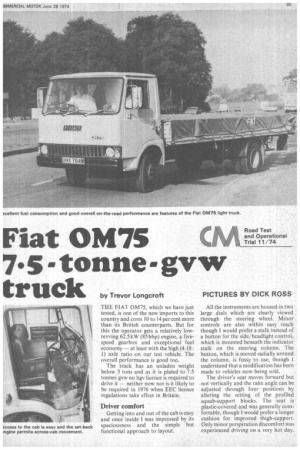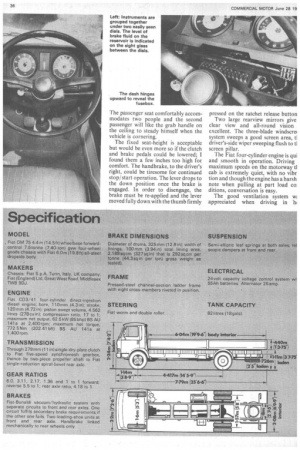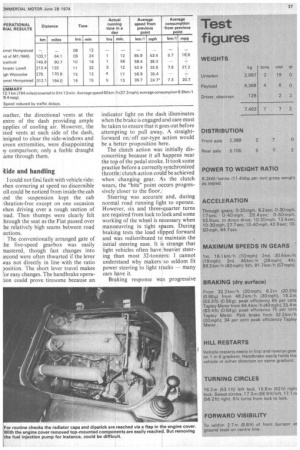Fiat 0M75 7.5 tonnegvw
Page 37

Page 38

Page 39

Page 40

If you've noticed an error in this article please click here to report it so we can fix it.
truck by Trevor Longcroft THE FIAT 0M75, which we have just tested, is one of the new imports to this country and costs 10 to 14 per cent more than its British counterparts. But for this the operator gets a relatively lowrevving 62.5 kW (85 bhp) engine, a fivespeed gearbox and exceptional fuel economy — at least with the high (4.18 : .1) axle ratio on our test vehicle. The overall performance is good too.
The truck has an unladen weight below 3 tons and as it is plated to 7.5 tonnes gvw no hgv licence is required to drive it neither now nor is it likely to be required in 1976 when EEC licence regulations take effect in Britain.
Driver comfort
Getting into and out of the cab is easy and once inside I was impressed by its spaciousness and the simple but functional approach to layout.
PICTURES BY DICK ROSS
All the instruments are housed in two large• dials which are clearly viewed through the steering wheel. Minor controls are also within easy reach though I would prefer a stalk instead of a button for the side/ headlight control, which is mounted beneath the indicator stalk on the steering column. The button, which is moved radially around the column, is fussy to use, though I understand that a modification has been ' made to vehicles now being sold.
The driver's seat moves forward but not vertically and the rake angle can be adjusted through four positions by altering the setting of the profiled squab-support blocks. The seat is plastic-covered and was generally comfortable, though I would prefer a longer cushion for improved thigh-support. Only minor perspiration discomfort was experienced driving on a very hot day. The passenger seat comfortably accommodates two people and the second passenger will like the grab handle on the ceiling to steady himself when the vehicle is cornering.
The fixed seat-height is acceptable but would be even more so if the clutch and brake pedals could be lowered; I found them a few inches too high for comfort. The handbrake, to the driver's right, could be tiresome for continued stop/ start operation. The lever drops to the down position once the brake is engaged. In order to disengage, the brake must be re-applied and the lever moved fully down with the thumb firmly pressed on the ratchet release button Two large rearview mirrors give clear view and all-round vision excellent. The three-blade windscrei system sweeps a good screen area, ti driver's-side wiper sweeping flush to tl screen pillar.
The Fiat four-cylinder engine is qui and smooth in operation. Driving maximum speeds on the motorway ti cab is extremely quiet, with no vibr tion and though the engine has a harsh note when pulling at part load co: ditions, conversation is easy.
The good ventilation system wi appreciated when driving in hi ieather, the directional vents at the entre of the dash providing ample upplies of cooling air. However, the ixed vents at each side of the dash, lesigned to clear the side-windows and creen extremities, were disappointing ))/ comparison; only a feeble draught ame through them.
Ride and handling
I could not find fault with vehicle ride: vhen cornering at speed no discernible oil could be noticed from inside the cab Lnd the suspension kept the cab 7ibration-free except on one occasion Olen driving over a rough section of .oad. Then thumps were clearly felt hrough the seat as the Fiat passed over he relatively high seams between road ;ections.
The conventionally arranged gate of he five-speed gearbox was easily nastered, though fast changes into ;econd were often thwarted if the lever Alas not directly in line with the ratio osition. The short lever travel makes For easy changes. The handbrake opera:ion could prove tiresome because an indicator light on the dash illuminates when the brake is engaged and care must be taken to ensure that it goes out before attempting to pull away. A straightforward on/ off car-type action would be a better proposition here.
The clutch action was initially disconcerting because it all happens near the top of the pedal stroke. It took some practice before a correctly synchronized throttle/ clutch action could be achieved when changing gear. As the clutch wears; the "bite" point occurs progressively1 closer to the floor.
Steering was accurate and, during normal road running light to operate. Howver, six and three-quarter turns are required from lock to lock and some working of the wheel is necessary when manoOvring in tight spaces. During braking tests the load slipped forward and Was redistributed to maintain the initial steering ease. It is strange that light vehicles often have heavier steering than most 32-tonners: I cannot understand why makers so seldom fit power steering to light trucks many cars have it.
Braking response was progressive though continuous use of the brakes, say when descending a gradient, increased the travel required as the Fiat neared the base of the gradient.
Performance
Outstanding fuel consumption was achieved by the Fiat over CM's Midlands test route. On the first motorway section. speeds in the high fifties were easily maintained and there was no need to change from fifth gear even on the steeper gradients. Consumption over this part of the route was 5.7km/1 (16.9mpg) and this was improved on in later sections; a very commendable overall consumption of 6.9 km/1 (19.4mpg) was returned.
Good consumption can be attributed to the even spacing of the five ratios and the engine's ability to pull without fuss at low revs, In top (direct) gear the Fiat will pull away from 16.1 km/1 (10 mph) on a flat road, though the power isn't noticeably felt until around 29 km/ h (17/ 18 mph). This flexibility permitted a large percentage of the route to be completed in top gear.
In top gear the Fiat would bowl happily along at close to 64 km/ h (40 mph) with the throttle only part open.
On Fish Hill at Broadway the Fiat completed the 2.1 km ( I.3-mile) climb with an average I in 8 gradient in just over five minutes.
Approximately half the time was spent in second gear at a typical speed of 29 km/ h (18 mph) with the engine pulling easily in the high rev range. The gradient at Aston Rowant was easily climbed in third gear at 46.5 km/ h (28 mph) though the steeper climb out of High Wycombe toward Amersham required second at a typical speed of 29 km/h (18 mph).
For general operation the Fiat pulls away comfortably in second gear and making full use of the gearbox a br acceleration, say from traffic lights, achieved. It is a pity that vehicles such the Fiat are restricted to 64.4 kn (40 mph) on good class "A" roads. I h count of the occasions on which we h to lead a queue of otherwise fast. moving traffic, although higher spec were easily within the vehicl capability.
Maintenance
For maintenance the dual passeni seat is hinged or removed before t engine cover is lifted. There is plenty room to reach the injectors and tc mounted engine components but reach the fuel-injection pump, I instance, could be a bit of a struggle. T radiator caps — there are, curious two of them close together — and di stick are reached through a flap in t engine cover and the air filter housing below the body, behind the cab. The inlet is at the top of the cab. In order remove the engine, the cab must also removed.
The Fiat is fitted with 8.5-17.5R tut less tyres. These are not fitted to oth vehicles currently available in the U though Fiat says that Michelin h stocks of this tyre.
Summary
My overall impression of the Fiat is a truck having a pleasing appearan. and offering an operator a good pa load capacity and extremely good fu consumption.
In terms of driver comfort I feel th some attention to the parking brake ar lowering the pedals would pay di% dends. As tested the Fiat 0M75 Ion. wheel-base chassis-cab costs £3,20 The 4.5 m-wheelbase version is ni available in this country with the Fi. dropside body.












































































































